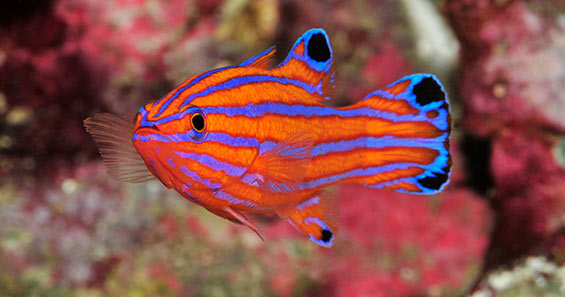By Scott W. Michael
There are a vast array of amazing fishes available to marine aquarists. Many of these sport beautiful colors or exhibit interesting behavior. But unfortunately, there are a good number of species available in the aquarium trade that are ill-suited to smaller to medium-sized home aquariums or are difficult to keep for other reasons. As responsible hobbyists, we should always be looking for fishes that will thrive in our home aquariums.
While many of the groupers (Family Serranidae) get way too large for the average home aquarium, there is one group of serranids, as well as some of their close relatives, that are ideally adapted to living in confined spaces. These fishes are the subjects of this article.
Part I: Reef Basslets (Family Serranidae: Genus Liopropoma)
The reef basslets are some of the smallest members of the grouper family. They range in size from 5 to around 25 cm (most reach lengths of less than 10 cm). They are not only smaller than most serranids, they are much more secretive than most of their cousins. Although many of the reef basslets are abundant in certain parts of their range, relatively little is known about them due to their secretive nature. They are rarely seen in open water, but instead, reside in caves and crevices. When divers do see them, it is when they are dashing from one hiding place to another or in the back of deep caves.
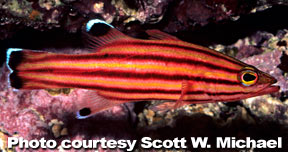 More and more of the Liopropoma spp. have been showing up in the aquarium trade. The first species to make a regular appearance in the trade was from the tropical Atlantic. The
Swissguard Basslet (Liopropoma rubre) was one of the first species I was able to find and keep. While it was once rare, it is now seen with regularity. In the last decade, more divers have begun to utilize mixed gas and re-breathers. These diving innovations have enabled collectors to explore deep reefs and, as a result, more Atlantic Liopropoma have become available, albeit at premium prices. The Candy Basslet (Liopropoma carmabi) is, in my opinion, the most exquisite of all reef fishes! It literally glows like a neon light. This fish is also very expensive. Its more chromatically-challenged congener, the Ridgeback or Cave Basslet (Liopropoma mowbrayi), is another species from this region that is occasionally offered, while the Wrasse Bass (L. eukrines) is now being collected in deep water off the east Florida coast.
More and more of the Liopropoma spp. have been showing up in the aquarium trade. The first species to make a regular appearance in the trade was from the tropical Atlantic. The
Swissguard Basslet (Liopropoma rubre) was one of the first species I was able to find and keep. While it was once rare, it is now seen with regularity. In the last decade, more divers have begun to utilize mixed gas and re-breathers. These diving innovations have enabled collectors to explore deep reefs and, as a result, more Atlantic Liopropoma have become available, albeit at premium prices. The Candy Basslet (Liopropoma carmabi) is, in my opinion, the most exquisite of all reef fishes! It literally glows like a neon light. This fish is also very expensive. Its more chromatically-challenged congener, the Ridgeback or Cave Basslet (Liopropoma mowbrayi), is another species from this region that is occasionally offered, while the Wrasse Bass (L. eukrines) is now being collected in deep water off the east Florida coast.
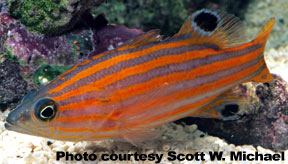 More recently, a group of cryptic Indo-Pacific basslets have been showing up in North American fish stores. The
Swalesi Basslet (Liopropoma swalesi) is a "poor-man's" Candy Bass. Although it is a lovely fish, somewhat similar in appearance to L. carmabi, its colors are not as stunning. But L. swalesi is much less expensive. The other basslets that have been showing up, include Collette's Reef Basslet (Liopropoma collettei), Headband Reef Basslet (L. mitratum), Many-lined Reef Basslet (L. multilineatum) and the Pinstripe Reef Basslet (L. susumi). There are also two undescribed species of reef basslets that have shown up in the aquarium trade in the last few years as well. One is very similar to L. swalesi but has red lines along the body, not orange, as well as other color differences. The other new species is the Yellowtail Reef Basslet, which is pink overall with a yellow tail and yellow lines on the head. Both will be described by Dr. Richard Pyle from the Bishop Museum in the future.
More recently, a group of cryptic Indo-Pacific basslets have been showing up in North American fish stores. The
Swalesi Basslet (Liopropoma swalesi) is a "poor-man's" Candy Bass. Although it is a lovely fish, somewhat similar in appearance to L. carmabi, its colors are not as stunning. But L. swalesi is much less expensive. The other basslets that have been showing up, include Collette's Reef Basslet (Liopropoma collettei), Headband Reef Basslet (L. mitratum), Many-lined Reef Basslet (L. multilineatum) and the Pinstripe Reef Basslet (L. susumi). There are also two undescribed species of reef basslets that have shown up in the aquarium trade in the last few years as well. One is very similar to L. swalesi but has red lines along the body, not orange, as well as other color differences. The other new species is the Yellowtail Reef Basslet, which is pink overall with a yellow tail and yellow lines on the head. Both will be described by Dr. Richard Pyle from the Bishop Museum in the future.
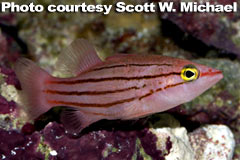 These basslets are wonderful aquarium fishes. They are especially well-suited to the reef aquarium. This captive venue is a perfect home for the Liopropoma spp. because of the numerous caves and crevices that are typically found in the reef tank. The smaller species can be successfully housed in a nano-reef aquarium (see dottyback account below for more on nano-reefs), while the larger species will do best if kept in a medium to large-sized aquarium. A colorful Liopropoma spp. would make a stunning addition to the smaller nano-reef aquarium. As we will discuss later, some of these fishes will actually do better if they are kept on their own.
These basslets are wonderful aquarium fishes. They are especially well-suited to the reef aquarium. This captive venue is a perfect home for the Liopropoma spp. because of the numerous caves and crevices that are typically found in the reef tank. The smaller species can be successfully housed in a nano-reef aquarium (see dottyback account below for more on nano-reefs), while the larger species will do best if kept in a medium to large-sized aquarium. A colorful Liopropoma spp. would make a stunning addition to the smaller nano-reef aquarium. As we will discuss later, some of these fishes will actually do better if they are kept on their own.
The Liopropoma spp. feed on crustaceans and small fishes. Remember this when you are selecting tankmates for a reef basslet - they have relatively large jaws which will enable them to consume relatively large prey items. These fishes will take a variety of captive fare, including shaved table shrimp,
frozen preparations for carnivores,
frozen mysid shrimp and
flake food. They will also feed on small crustaceans (e.g., amphipods,
copepods) that live in and among the live rocks of your reef aquarium. If housed in a reef tank with a healthy crustacean stock, they should be fed two or three times a week. In a tank without natural fodder they should be fed daily. One problem with some colorful reef fishes is that they tend to lose their color in captivity. The reef basslets are relatively "color fast," but it may occur unless you give them a varied diet that includes foods with appropriate pigments.
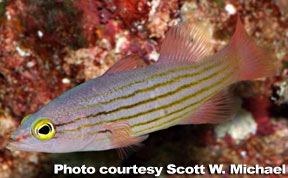 When initially introduced into the aquarium, a Liopropoma spp. may hide for several days, or even a couple of weeks, before coming out to inspect their new surroundings. Although they may never become as bold as a butterflyfish or clownfish, they will gradually become a more conspicuous part of your fish community. (Be aware, there are a few species of reef basslet, like Swale's Reef Basslet (Liopropoma swalesi), that are so secretive that they may disappear for months!) One thing that will prevent their successful acclimation is aggressive tankmates. If these basslets are kept with bellicose fish, they often hide and will not eat.
When initially introduced into the aquarium, a Liopropoma spp. may hide for several days, or even a couple of weeks, before coming out to inspect their new surroundings. Although they may never become as bold as a butterflyfish or clownfish, they will gradually become a more conspicuous part of your fish community. (Be aware, there are a few species of reef basslet, like Swale's Reef Basslet (Liopropoma swalesi), that are so secretive that they may disappear for months!) One thing that will prevent their successful acclimation is aggressive tankmates. If these basslets are kept with bellicose fish, they often hide and will not eat.
One of the most appealing attributes of the smaller Liopropoma spp. is that they are rarely aggressive to other, unrelated fishes. Two Liopropoma basslets of different species can be kept in the same large aquarium (i.e., 100 gallons or more) if they are introduced simultaneously and if plenty of hiding places are provided. Members of the same species should not be kept together unless you have an extra-large aquarium (i.e., 180 gallons or more) with lots of hiding places or you can acquire a known, mated pair. Even then a larger, more dominant individual may harass a subordinate when they cross paths. Fighting between conspecifics can be violent, often involving vicious jaw locking behavior, and can lead to the death of subordinate individuals. They will occasionally skirmish over a hiding place with other basslets or other cryptic fish species (e.g., cardinalfishes), but this can be prevented by providing numerous crevices and caves. Those species that are typically found on vertical drop-offs will appreciate a steep wall of rock in their aquarium home.
Part 1
Reef Basslets
(Family Serranidae:
Genus Liopropoma) |
| |
Part 2
Grammas
(Family Grammatidae:
Genus Gramma) |

 Scott Michael
Scott Michael
Scott W. Michael is an internationally-recognized writer, underwater photographer, and marine biology researcher specializing in reef fishes, and was the Banquet Speaker at our 2007 and 2008 Coral Conference and Frag Swap. He is a regular contributor to Aquarium Fish Magazine, Freshwater and Marine Aquarium Magazine, SeaScope, and is the author of
Reef Fishes Vol 1,
Vol 2, and
Vol 3, Vol 4, and Vol 5.,
A Pocket Expert Guide Marine Fishes,
A Pocket Expert Guide to Reef Aquarium Fishes, 101 Best Saltwater Fishes: How to Choose and Keep Hardy, Brilliant, Fascinating Species That Will Thrive in Your Home Aquarium, Reef Sharks & Rays of the World, and Aquarium Sharks & Rays. Having studied marine biology at the University of Nebraska, Scott has served as a scientific consultant for National Geographic Explorer, the Discovery Channel, and French educational television.
|
 Scott Michael
Scott Michael


